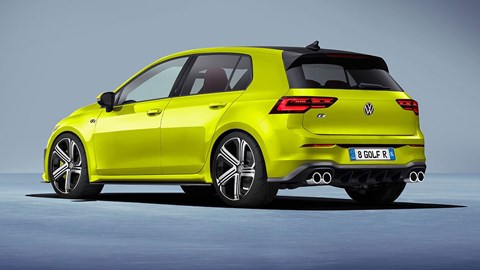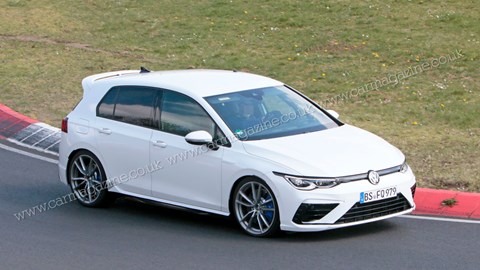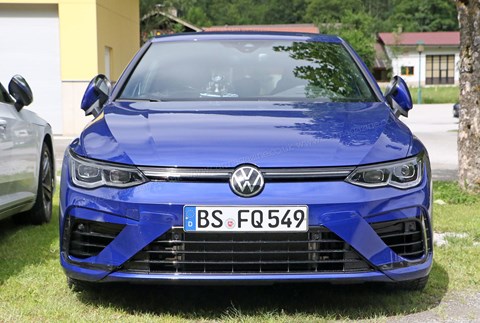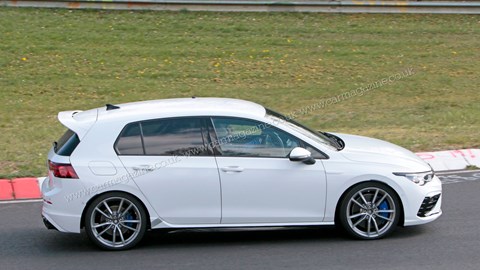► Estate R spotted
► Plus scoop dossier on new 2021 Mk8
► And news of even hotter R+ hyper hatchI
Our spy photographers have snapped an estate version of the Golf R testing, as VW looks to roll out its most practical take on the R formula.
The prototype pictured certainly looks interesting, though; VW engineers have camouflaged the estate R to look like an Alltrack version of the Mk8 – but there are a few clues for more attentive viewers: Quad exhaust pipes and dish-sized brake discs put this car firmly in the R category.

We’d expect VW to drop the same engine already shown in the estate, though we won’t see the car for a while; neither the R nor the standard Mk8 have been shown yet. Expect to see something early next year, though
Best hot hatches in 2020

VW Golf R: what to expect from the expanded range of hot hatches
Facing stiff competition from newer rivals, such as the Hyundai i30 N and Honda Civic Type R, VW is mounting a multi-tier approach for its refreshed performance hatch line-up. Leading the charge is the all-new Golf GTI, which has now been unveiled with the EA888 turbocharged 2.0-litre producing 242bhp and 295lb ft.
Slotting above the GTI will be the new Mk8 Golf R, depicted in our earlier artist’s impressions below.

Leaked internal documents show the hotly anticipated pinnacle of the line-up (at least in the short-term) is unlikely to shift away from a proven formula, instead stepping up outputs from the familiar 2.0-litre four-cylinder turbo to 329bhp.
At that level it will be the most powerful production Golf to date, and the 4Motion all-wheel drive will be retained to deploy all that power evenly across both axles. Engineers have been busily tuning the chassis on the Nurburgring (see spyshots below).

Drive will continue through all four wheels and the chassis will be appropriately tweaked to handle the extra punch, along with DCC (Dynamic Chassis Control) adaptive dampers.
Our latest spy photos confirm the now-typical Golf R dual exhausts hanging from either side of the rear end. Blue brake calipers pinching cross-drilled front rotors promise to bolster stopping power, while a revised bumper and unique lower rear diffuser assist with cooling and high-speed stability while also ensuring the requisite increase in visual aggression.
Bridging the gap between the revamped Golf GTI and Golf R will be a new variant dubbed GTI TCR, which will form a halfway house between the two familiar Golf performance models.

Where the new GTI caps power at 242bhp, the TCR will feed 296bhp from its EA888 engine to the front treads. The new Mk8 variant is expected to switch to a five-door configuration, and gain some aggressive new bodywork inspired by the race car with which it shares the badge.
Other additions for the TCR include extra cooling, a sports exhaust and track-focused rubber.
While the new-gen Golf R and TCR are a done deal, it’s the prospect of the long-rumoured Golf R ‘Plus’ that is most intriguing.

A new Golf R Plus – with hybrid power
This halo model, which could have as much as 402bhp and would act as a more affordable rival to the likes of the Mercedes-AMG A45, has been discussed deep within Volkswagen’s Wolfsburg head office, with boss Herbert Diess reported to be a personal proponent of the project.
However, while rumours of the hot hatch halo have been circulating for months, Wheels sources say the car is yet to get the crucial management sign-off. That means it’s not in the mid-term product plan and, even if given the green light, it won’t appear until at least 2023.
Another marketing-friendly option could be a 2024 launch to celebrate the 50th anniversary of the iconic GTI.
Chassis tweaks would naturally run to stiffer suspension and, according to our spies, a wider track, something that would necessitate bespoke wheelarches to keep everything in check – and pump up the aesthetics.
It would also create a distinct look from the GTI and R models, which would continue to account for the bulk of hot Golf sales.
It’s understood that engineers have evaluated multiple drivetrain options for getting the requisite power – with Mercedes-AMG’s 416bhp A45 one target mentioned – while meeting stringent 95g/km CO2 targets.
Whatever happens, expect emissions as much as performance to steer the agenda.
There’s also the rather large hurdle of ensuring any top-shelf Golf arrives with a Volkswagen-friendly price tag. Sister brand Audi does a thoroughly reasonable RS3, so R Plus would logically either have to offer more or sell for less – likely the latter.

Volkswagen executives initially considered employing Audi’s potent and characterful 394bhp five-cylinder turbo as the powerplant for a Plus-powered Golf, but that plan has been killed off. Instead, it would be up to the familiar 2.0-litre blown four-pot to carry the Golf to a new level of performance, but what form it takes has apparently not been decided.
While a heftier turbo and strengthened internals could theoretically hit the 400bhp-plus target, another option understood to be on the table involves electrification.
That would leave an electric motor to provide something like an extra 70-plus brakehorsepower, possibly more – all of which would blend nicely with Volkswagen’s broader switch to electric propulsion through its ID sub-brand.
It makes sense given Volkswagen’s performance direction too. The recently unveiled Touareg R utilises the 456bhp plug-in hybrid drivetrain from Porsche’s Cayenne E-Hybrid.

However, there are challenges for an R Plus elsewhere. Any such program is unlikely to be for a single model, suggesting other vehicles within the group would need to utilise such a set-up to ensure its viability. There’s also the issue of weight. Throw in batteries and there’s the obvious issue of adding hundreds of kilograms to the car, which would trade off its agility.
On the other hand, electric motors also allow different thinking on the drivetrain front.
Rather than run driveshafts to the rear, Volkswagen could use the same approach as other all-wheel-drive hybrids – and the GTI Worthersee concept from 2017 – that leave the petrol engine powering the front axle while electric motors take care of the rear drive. Such a set-up would also help to overcome some of the weight disadvantage of carrying batteries and motors in addition to the ICE by eliminating diffs and driveshafts.
There are also benefits with torque vectoring and being able to quickly switch drive between wheels and axles depending on the surface and situation. It’s thinking that is already deep in development elsewhere across Europe.
What approach VW will adopt remains to be seen, though it’s clear the brand isn’t taking losing its place at the top of the hot hatch hierarchy lying down.
And the real winners in that scenario are us – car lovers looking for engaging daily drivers that can also lug the kids and dog about, without breaking the bank.
This article originally appeared on whichcar.com.au